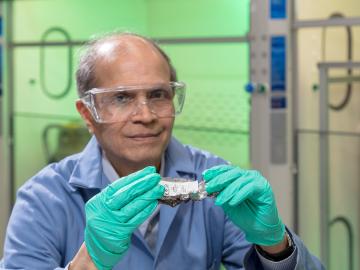
Filter News
Area of Research
- (-) Materials (52)
- (-) Nuclear Science and Technology (22)
- Advanced Manufacturing (5)
- Biology and Environment (17)
- Clean Energy (70)
- Climate and Environmental Systems (2)
- Computer Science (2)
- Energy Sciences (1)
- Fusion and Fission (6)
- Fusion Energy (5)
- Isotopes (5)
- Materials for Computing (5)
- National Security (14)
- Neutron Science (28)
- Nuclear Systems Modeling, Simulation and Validation (2)
- Quantum information Science (3)
- Supercomputing (38)
News Topics
- 3-D Printing/Advanced Manufacturing (7)
- Advanced Reactors (7)
- Artificial Intelligence (2)
- Big Data (2)
- Bioenergy (4)
- Biomedical (2)
- Chemical Sciences (3)
- Climate Change (1)
- Composites (1)
- Computer Science (9)
- Coronavirus (2)
- Critical Materials (3)
- Cybersecurity (2)
- Decarbonization (1)
- Energy Storage (9)
- Environment (4)
- Exascale Computing (1)
- Fusion (6)
- Isotopes (4)
- Machine Learning (3)
- Materials (1)
- Materials Science (30)
- Mathematics (1)
- Microscopy (5)
- Molten Salt (2)
- Nanotechnology (12)
- National Security (1)
- Neutron Science (13)
- Nuclear Energy (20)
- Partnerships (1)
- Physics (9)
- Polymers (4)
- Quantum Science (4)
- Security (1)
- Space Exploration (2)
- Summit (2)
- Sustainable Energy (6)
- Transformational Challenge Reactor (4)
- Transportation (4)
Media Contacts

In the 1960s, Oak Ridge National Laboratory's four-year Molten Salt Reactor Experiment tested the viability of liquid fuel reactors for commercial power generation. Results from that historic experiment recently became the basis for the first-ever molten salt reactor benchmark.

In the Physics Division of the Department of Energy’s Oak Ridge National Laboratory, James (“Mitch”) Allmond conducts experiments and uses theoretical models to advance our understanding of the structure of atomic nuclei, which are made of various combinations of protons and neutrons (nucleons).

In the race to identify solutions to the COVID-19 pandemic, researchers at the Department of Energy’s Oak Ridge National Laboratory are joining the fight by applying expertise in computational science, advanced manufacturing, data science and neutron science.

As a teenager, Kat Royston had a lot of questions. Then an advanced-placement class in physics convinced her all the answers were out there.

Scientists at Oak Ridge National Laboratory used a focused beam of electrons to stitch platinum-silicon molecules into graphene, marking the first deliberate insertion of artificial molecules into a graphene host matrix.

Oak Ridge National Laboratory researchers working on neutron imaging capabilities for nuclear materials have developed a process for seeing the inside of uranium particles – without cutting them open.

A software package, 10 years in the making, that can predict the behavior of nuclear reactors’ cores with stunning accuracy has been licensed commercially for the first time.

The techniques Theodore Biewer and his colleagues are using to measure whether plasma has the right conditions to create fusion have been around awhile.

Three technologies and one commercialization program developed at the Department of Energy’s Oak Ridge National Laboratory have won National Technology Transfer Awards from the Federal Laboratory Consortium.

Joe Paddison, a Eugene P. Wigner Fellow at the Department of Energy’s Oak Ridge National Laboratory, believes there’s more information to be found in neutron scattering data than scientists like himself might expect.


